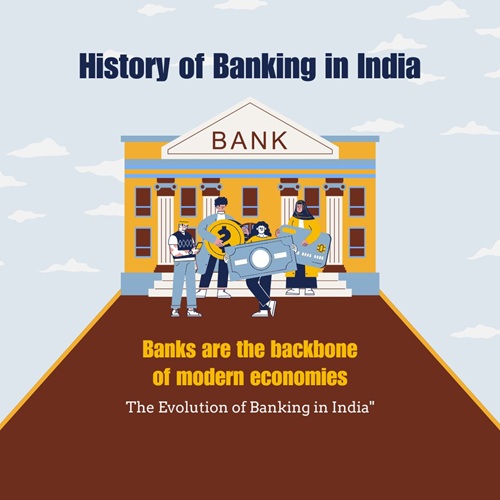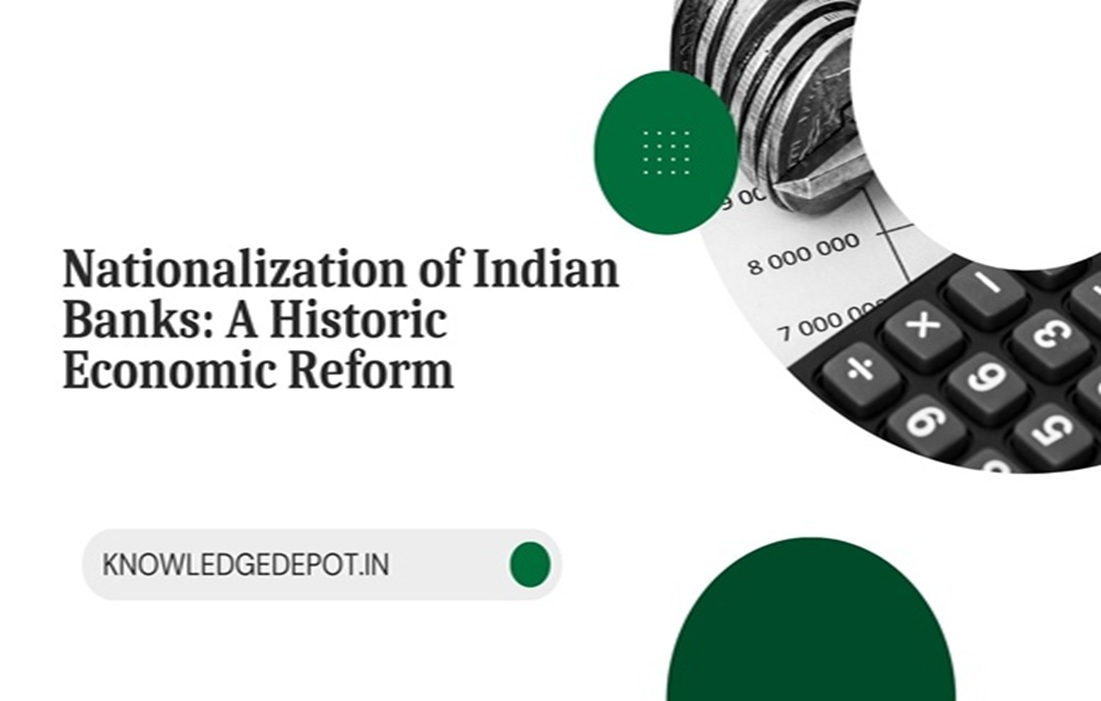Introduction
The history of banking in India is a fascinating journey that traces its roots from ancient times to the modern digital banking era. Over the centuries, India’s banking system has evolved from informal lending practices in the Vedic period to the establishment of highly regulated public and private sector banks. This transformation has played a crucial role in shaping the country’s economic landscape.
In this comprehensive article, we will explore the evolution of banking in India, covering its different phases, major reforms, and technological advancements.
1. Ancient Banking System in India
1.1 Banking in the Vedic Period (1500–500 BCE)
- Banking in India can be traced back to the Vedic period, where money lending was a common practice.
- Merchants and moneylenders (Shroffs, Mahajans, Seths, and Sahukars) provided loans to traders and farmers.
- Temples acted as financial institutions, safeguarding wealth and even lending money.
1.2 Banking in the Maurya and Gupta Empires (321 BCE – 550 CE)
- During Chandragupta Maurya’s reign, banking became more structured with written loan agreements.
- The Arthashastra (by Chanakya) provided detailed information about financial transactions, loans, and interest rates.
- The Gupta Empire (319-550 CE) saw the use of bills of exchange (Hundi), which later became an integral part of Indian banking.
2. Medieval Banking in India (12th – 18th Century)
2.1 Role of Indigenous Bankers (Shroffs, Seths, and Sahukars)
- During the medieval period, indigenous bankers played a major role in trade financing.
- Shroffs, Seths, and Sahukars provided credit to merchants and helped in inter-regional trade.
- The use of Hundis (promissory notes) became widespread for secure money transfers.
2.2 Mughal Era Banking
- Banking thrived under the Mughals (1526–1857) due to the flourishing trade network.
- Hundis were extensively used for long-distance transactions.
- Jagat Seths, a prominent banking family, controlled significant financial transactions for the Mughal Empire.
3. Colonial Era: Foundation of Modern Banking (18th – 20th Century)
3.1 Establishment of Early Banks
- The British introduced the concept of formal banking institutions in India.
- The first bank in India, The Bank of Hindustan, was established in 1770 by the British.
3.2 Introduction of Presidency Banks
- The British founded three major banks:
- Bank of Calcutta (1806) (later renamed Bank of Bengal).
- Bank of Bombay (1840).
- Bank of Madras (1843).
- These three banks were later merged in 1921 to form the Imperial Bank of India, which became the State Bank of India (SBI) in 1955.
3.3 Rise of Indian-Owned Banks
- The Swadeshi Movement (1905) encouraged Indians to establish their own banks:
- Allahabad Bank (1865) – First Indian joint-stock bank.
- Punjab National Bank (1894) – Founded by Indian entrepreneurs.
- Bank of India (1906) and Central Bank of India (1911) were among the first Indian-owned banks.
3.4 The Reserve Bank of India (RBI) – 1935
- RBI was established in 1935 to regulate banking in India.
- It was nationalized in 1949, making it the central authority for monetary policy.
4. Banking Post-Independence (1947 – 1990)
4.1 Nationalization of Banks (1969 & 1980)
- To promote financial inclusion, Indira Gandhi’s government nationalized 14 major banks in 1969.
- In 1980, six more banks were nationalized, bringing the total to 20 public sector banks.
- This increased banking penetration in rural and semi-urban areas.
4.2 Regional Rural Banks (RRBs) – 1975
- RRBs were introduced to improve rural banking and agriculture financing.
- NABARD (National Bank for Agriculture and Rural Development) was established in 1982 to support rural credit institutions.
5. Liberalization and Banking Reforms (1991 – 2000s)
5.1 Entry of Private and Foreign Banks
- The 1991 Economic Reforms allowed private sector banks to operate.
- New-generation banks like HDFC, ICICI, and Axis Bank emerged.
- Foreign banks (Citi Bank, HSBC, and Standard Chartered) expanded operations.
5.2 Technological Advancements
- ATMs were introduced in the late 1990s for easier cash withdrawals.
- Online banking and core banking solutions were implemented by major banks.
- NEFT (2005) and RTGS (2004) were introduced for digital fund transfers.
6. Modern Banking in India (2000 – Present)
6.1 Digital Revolution in Banking
- UPI (Unified Payments Interface) was launched in 2016, transforming digital payments.
- Mobile wallets (Paytm, Google Pay, PhonePe, etc.) gained popularity.
- Fintech startups emerged, offering AI-driven financial services.
6.2 Small Finance and Payment Banks
- Small Finance Banks (SFBs) and Payment Banks were introduced to enhance financial inclusion.
- Airtel Payments Bank, Paytm Payments Bank, and India Post Payments Bank were launched.
6.3 Impact of COVID-19 on Banking
- The pandemic accelerated digital banking adoption and remote banking services.
- Banks strengthened cybersecurity measures to protect online transactions.
4. Banking Post-Independence (1947 – 1990)
4.1 Nationalization of Banks
- In 1949, the Reserve Bank of India (RBI) was nationalized, making it the central authority for monetary policy.
- In 1969, Indira Gandhi nationalized 14 major banks to enhance financial inclusion.
- In 1980, 6 more banks were nationalized, bringing the total to 20 nationalized banks.
4.2 Formation of Regional Rural Banks (RRBs) in 1975
- The Indian government established Regional Rural Banks (RRBs) to promote banking in rural areas.
- This helped increase financial services in agriculture, small businesses, and weaker sections of society.
5. Banking Reforms and Liberalization (1991 – 2000s)
5.1 Liberalization and Privatization (1991)
- The 1991 Economic Reforms led to the entry of private and foreign banks in India.
- New generation banks such as ICICI, HDFC, and Axis Bank started operations.
- Competition increased, leading to better customer service and technology-driven banking.
5.2 Introduction of ATMs and Internet Banking
- In the late 1990s, ATMs and electronic banking services started gaining popularity.
- Online banking, mobile banking, and card-based transactions became mainstream.
6. Modern Banking in India (2000 – Present)
6.1 Digital Revolution and Fintech
- Introduction of UPI (Unified Payments Interface) in 2016 revolutionized the payments ecosystem.
- Digital wallets (Paytm, Google Pay, PhonePe, etc.) became dominant in online transactions.
- The rise of Neo-banks and fintech startups transformed banking services.
6.2 Rise of Small Finance and Payment Banks
- Small Finance Banks (SFBs) and Payment Banks (like Paytm Payments Bank, Airtel Payments Bank, etc.) were introduced to enhance financial inclusion.
6.3 Banking During and After COVID-19
- COVID-19 accelerated the shift to digital banking and contactless payments.
- Banks focused on cybersecurity, AI-driven banking, and blockchain technology for secure transactions.
7. Future of Banking in India
7.1 Key Trends Shaping Indian Banking
- AI & Machine Learning in Banking for personalized financial services.
- Blockchain technology for secure transactions and digital contracts.
- Green Banking & Sustainable Finance for eco-friendly investments.
- Central Bank Digital Currency (CBDC) by RBI to introduce digital rupee.
7.2 Challenges in the Banking Sector
- Rising non-performing assets (NPAs) and loan defaults.
- Cybersecurity threats due to increasing digital transactions.
- Financial inclusion and bridging the rural-urban banking gap.
Conclusion
The Indian banking system has undergone significant transformations, evolving from ancient money lending practices to digital banking and fintech-driven innovations. Each phase of banking history has contributed to the economic growth, financial stability, and technological advancements of the country.
With AI, blockchain, and digital currencies shaping the future, the Indian banking sector is poised for a revolutionary shift in the coming years. Ensuring financial security, inclusion, and technological progress will be key to sustaining this growth.

